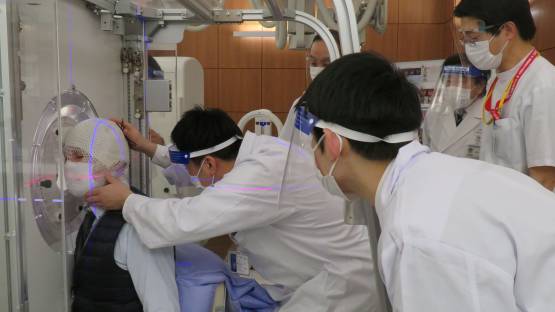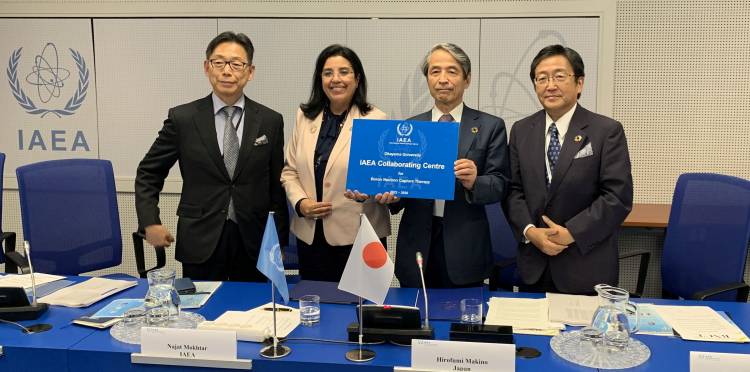The IAEA and Japan’s Okayama University have agreed to work together in the area of Boron Neutron Capture Therapy (BNCT), a non-invasive therapeutic technique for treating invasive malignant tumours. An agreement signed yesterday in Vienna during the IAEA’s 66th General Conference designates Okayama University as the first IAEA Collaborating Centre in this field.
The IAEA and Okayama University have a long history of collaboration on BNCT, a neutron-based radiotherapy technique for cancer. This very targeted technique relies on a boron-containing pharmaceutical being preferentially taken up in tumour cells and subsequently the tumour area is irradiated with neutrons.
Under the terms of the new Collaborating Centre agreement, Okayama University will:
- Provide assistance to institutions aiming to build a BNCT facility;
- Provide education and training for BNCT specialists;
- host young female graduate students with an interest in this field under IAEA’s Marie Sklodowska-Curie Fellowship Programme; and
- Develop standardized protocols in support of BNCT.
Okayama University’s existing specialized medical physics course on BNCT will be translated into English for a broader world audience, and the university will also organize research into the measurement of the distribution of boron pharmaceuticals in tissues.
Growing global interest in advances in BNCT
Significant advances in recent years have led to the development of compact accelerator-based neutron sources that can be installed in hospitals. There, they can be registered as medical devices and provide BNCT in a clinical environment. In Japan, regulatory approval was gained for a cyclotron based BNCT system, treatment planning device and a boron-containing pharmaceutical for use in the routine clinical treatment for recurrent, unresectable head and neck cancer. This has stimulated interest around the world with several commercial companies entering the market and many new facilities under construction or planning, bringing the world to more than 30 facilities involved in work related to BNCT.
The IAEA produced a report on BNCT in 2001 entitled Current status of neutron capture therapy, which has remained one of the major references in the field. It was realised that it was time for a new report on BNCT to reflect the large changes that have taken place in the field in the last two decades. Under the existing Practical Arrangements, Okayama University’s Neutron Therapy Research Center provided much of the coordination of the world’s BNCT community during two large Technical Meetings held in 2020 and 2022, and during the drafting of a new TECDOC that is expected to be published in the next few months.
“This Collaborating Centre Agreement comes at a time when interest is growing widely around the world in BNCT, and Okayama University provides a good focal point for IAEA activities in the field,” said Najat Mokhtar, IAEA Deputy Director General and Head of the Department of Nuclear Sciences and Applications.
“As an IAEA Collaborating Centre, the Okayama University intends to further accelerate its cooperation with the IAEA on technical development and educational programmes for a new generation of BNCT,” added Hirofumi Makino, President of the Okayama University. “We will engage in active information sharing as a global hub of research, development, and education for BNCT and strive to contribute to world health and peace.”
BNCT: The Science Behind
Patients undergoing BNCT are given a boron-based reagent, often injected intravenously, which accumulates in cancer cells. When a stable boron isotope (boron-10) of the reagent is hit by a beam of neutrons in the cancer cells, it captures neutrons, which causes a nuclear reaction and creation of energetic helium (alpha particle) and lithium nuclei. The nuclei deposit their energy within the tumour cell, causing damage and cell death. The tumour is targeted by selectively introducing the boron reagent into tumour cells, and not by aiming the beam at the cells, as in other radiation therapies, in which healthy tissue still may get damaged as a result. The high biological effectiveness of this procedure and the precisely targeted cell damage are major advantages of BNCT in clinical therapy.
IAEA Collaborating Centres
To promote the use of nuclear technologies, the IAEA collaborates with designated institutions around the world. Through the Collaborating Centres network, these organizations assist the IAEA by undertaking original research and development and training relating to nuclear science, technologies and their safe and secure applications. There are currently 58 active IAEA Collaborating Centres in 36 countries, working on helping Member States reach the United Nations Sustainable Development Goals.
We will engage in active information sharing as a global hub of research, development, and education for BNCT and strive to contribute to world health and peace.




